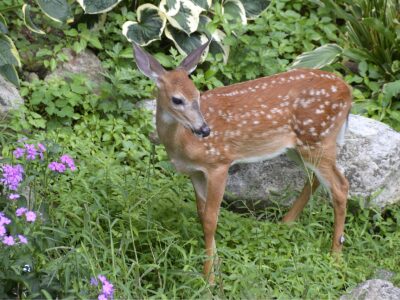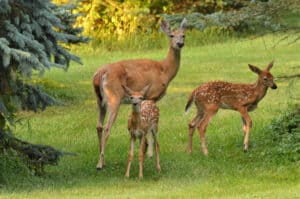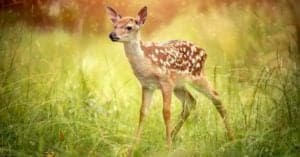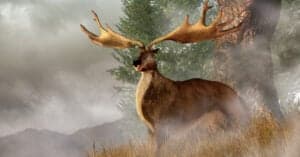What Do Fawns Eat?
The word fawn refers to more than just a color, or a behavior; it’s also what we call a baby deer. Members of the Cervidae family—which includes elk, moose, reindeer (caribou), red deer, roe deer, white-tailed deer, key deer, fallow deer, and mule deer, among others—are known as fawns until they reach one year of age. Fawns are characterized by their long spindly legs, oversized ears, tan bodies, and white spots.
Here, we’ll learn more about what fawns eat, how they transition from mother’s milk to greens, and how long it takes them to mature. Then, we’ll explore the ways that wildlife rescue organizations feed and rehabilitate these small deer.
The Fawn’s Favorite Foods
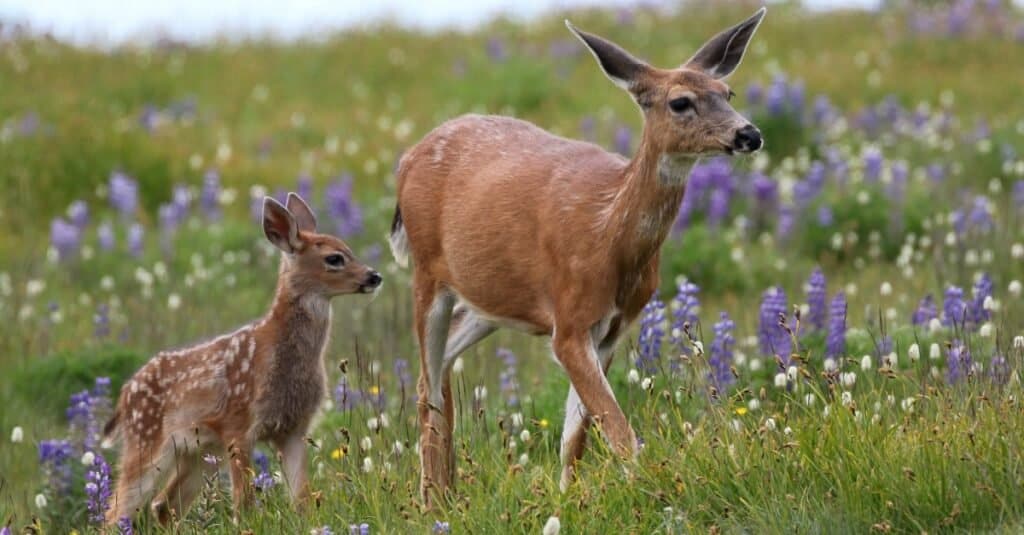
iStock.com/randimal
Fawns eat exclusively mother’s milk for the first two weeks of life. They are herbivores, and once weaned will eat primarily leaves, twigs, and other greens.
Fawns weigh between 4-8 pounds at birth. By drinking only mother’s milk, which is rich in fat, sugar, and protein, they double in weight in the first two weeks of life. After one month they will have tripled their birth weight. Once they’re a couple of weeks old, they start nibbling on tender grasses and new shoots, but just enough to get their ruminant, four part stomach started.
A Complete List of Foods that Fawns Eat:
- Mother’s milk
- Grasses
- Leaves
- Twigs
- Sedges
- Forbs
- Shrubs
- Trees
- Young roots and tubers
- Berries
- Fruit
- Lichen & fungi (in the winter)
What Do Wild Fawns Eat?
Wild fawns are completely dependent on their mothers for the first several weeks of life. The mother feeds the fawn around eight times a day, allowing it to nurse until it’s had its fill.
Fawns eat a lot of milk; between 10-20% of their body weight every day. When the mother is not feeding the fawn, she leaves it in an area with thick, low to the ground growth, where the fawn hides until the mother returns.
Wild fawns are nearly odorless, and since they don’t move or make a sound while the mother is gone, they are very hard for predators to find. They have to be; until the fawn is about a month old, it isn’t able to run from predators.
Fawns rely so much on this undetectability that they actually can’t expel waste, the smell of which would give away their location, without stimulation. The fawn won’t urinate or defecate until either they, or the mother, licks their genital region to stimulate the processes. The mother then immediately eats the waste, further ensuring that her fawn will remain undetectable by predators and survive to adulthood.
Surviving Through the Winter

iStock.com/nearandfar
Fawns are normally born in the spring months between April and June. The earlier they are born, the better chance they have at surviving through the next winter. At just three weeks old they start venturing out with their mother to nibble on tender grasses. They gradually replace more and more of the milk in their diet with greens like twigs, leaves, and young shoots. By the time they are 3-4 months old they are almost fully weaned.
Fawns won’t stop ‘nursing’ from their mother’s just because they’re weaned though; they have been observed ‘nursing’ well into their first winter, long after the mother has stopped providing milk. Scientists think this behavior may act as a bonding agent between the mother and fawn, or it may simply be a way for the weaned fawn to derive comfort.
What Do Captive Fawns Eat?
Many people find lone fawns, seemingly abandoned or motherless, and mistakenly ‘rescue’ them. As we’ve learned, these fawns are almost certainly not far from their mothers, and should be left alone unless they are visibly injured or distressed. Regardless, many wildlife rescue organizations exist that know how to care for fawns, and eventually rehabilitate them to the wild.
Fawns have very high nutritional needs, and if the wildlife organization cannot immediately return them to their mother, it’s up to them to meet these needs. Captive fawns eat either goat milk or a milk substitute. Dairy milk is not recommended as the fawns have a hard time digesting it.
But caretakers often take the fawn’s nutrition a step further by feeding them fruits, vegetables, and leafy greens. Fawns are fond of sweet things like fruit, and will happily eat bananas, strawberries, berries, oranges, pears, watermelons, and apples. They can also be fed vegetables like carrots, and starches like corn, barley, and wheat.
Though these foods make excellent treats for fawns, their primary food for the first 3-4 months of life should be milk. As they begin eating more solids, they should be fed on a mix of grasses, forbs, and shoots, in addition to their treats, in order to meet all of their nutritional requirements.
Do Fawns Need to Drink Water?
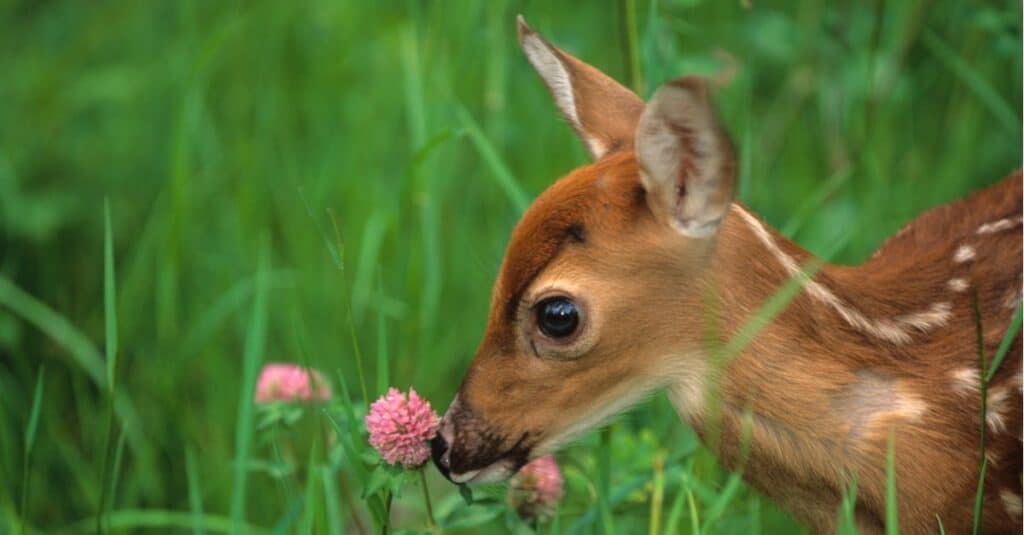
iStock.com/twildlife
Though the moisture content of mother’s milk is very high, fawns still have to drink water. This is the case for both wild and captive fawns. In northern climates, where the air turns cold and the leaves fall from the trees, weaned fawns survive largely on lichen and fungi. They get some moisture from these foods, but have also been observed eating snow to get all the water they need.
More from A-Z Animals
The word fawn refers to more than just a color, or a behavior; it’s also what we call a baby deer. Members of the Cervidae family—which includes elk, moose, reindeer (caribou), red deer, roe deer, white-tailed deer, key deer, fallow deer, and mule deer, among others—are known as fawns until they reach one year of age. Fawns are characterized by their long spindly legs, oversized ears, tan bodies, and white spots.
Here, we’ll learn more about what fawns eat, how they transition from mother’s milk to greens, and how long it takes them to mature. Then, we’ll explore the ways that wildlife rescue organizations feed and rehabilitate these small deer.
The Fawn’s Favorite Foods

iStock.com/randimal
Fawns eat exclusively mother’s milk for the first two weeks of life. They are herbivores, and once weaned will eat primarily leaves, twigs, and other greens.
Fawns weigh between 4-8 pounds at birth. By drinking only mother’s milk, which is rich in fat, sugar, and protein, they double in weight in the first two weeks of life. After one month they will have tripled their birth weight. Once they’re a couple of weeks old, they start nibbling on tender grasses and new shoots, but just enough to get their ruminant, four part stomach started.
A Complete List of Foods that Fawns Eat:
- Mother’s milk
- Grasses
- Leaves
- Twigs
- Sedges
- Forbs
- Shrubs
- Trees
- Young roots and tubers
- Berries
- Fruit
- Lichen & fungi (in the winter)
What Do Wild Fawns Eat?
Wild fawns are completely dependent on their mothers for the first several weeks of life. The mother feeds the fawn around eight times a day, allowing it to nurse until it’s had its fill.
Fawns eat a lot of milk; between 10-20% of their body weight every day. When the mother is not feeding the fawn, she leaves it in an area with thick, low to the ground growth, where the fawn hides until the mother returns.
Wild fawns are nearly odorless, and since they don’t move or make a sound while the mother is gone, they are very hard for predators to find. They have to be; until the fawn is about a month old, it isn’t able to run from predators.
Fawns rely so much on this undetectability that they actually can’t expel waste, the smell of which would give away their location, without stimulation. The fawn won’t urinate or defecate until either they, or the mother, licks their genital region to stimulate the processes. The mother then immediately eats the waste, further ensuring that her fawn will remain undetectable by predators and survive to adulthood.
Surviving Through the Winter

iStock.com/nearandfar
Fawns are normally born in the spring months between April and June. The earlier they are born, the better chance they have at surviving through the next winter. At just three weeks old they start venturing out with their mother to nibble on tender grasses. They gradually replace more and more of the milk in their diet with greens like twigs, leaves, and young shoots. By the time they are 3-4 months old they are almost fully weaned.
Fawns won’t stop ‘nursing’ from their mother’s just because they’re weaned though; they have been observed ‘nursing’ well into their first winter, long after the mother has stopped providing milk. Scientists think this behavior may act as a bonding agent between the mother and fawn, or it may simply be a way for the weaned fawn to derive comfort.
What Do Captive Fawns Eat?
Many people find lone fawns, seemingly abandoned or motherless, and mistakenly ‘rescue’ them. As we’ve learned, these fawns are almost certainly not far from their mothers, and should be left alone unless they are visibly injured or distressed. Regardless, many wildlife rescue organizations exist that know how to care for fawns, and eventually rehabilitate them to the wild.
Fawns have very high nutritional needs, and if the wildlife organization cannot immediately return them to their mother, it’s up to them to meet these needs. Captive fawns eat either goat milk or a milk substitute. Dairy milk is not recommended as the fawns have a hard time digesting it.
But caretakers often take the fawn’s nutrition a step further by feeding them fruits, vegetables, and leafy greens. Fawns are fond of sweet things like fruit, and will happily eat bananas, strawberries, berries, oranges, pears, watermelons, and apples. They can also be fed vegetables like carrots, and starches like corn, barley, and wheat.
Though these foods make excellent treats for fawns, their primary food for the first 3-4 months of life should be milk. As they begin eating more solids, they should be fed on a mix of grasses, forbs, and shoots, in addition to their treats, in order to meet all of their nutritional requirements.
Do Fawns Need to Drink Water?

iStock.com/twildlife
Though the moisture content of mother’s milk is very high, fawns still have to drink water. This is the case for both wild and captive fawns. In northern climates, where the air turns cold and the leaves fall from the trees, weaned fawns survive largely on lichen and fungi. They get some moisture from these foods, but have also been observed eating snow to get all the water they need.

